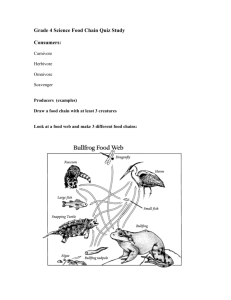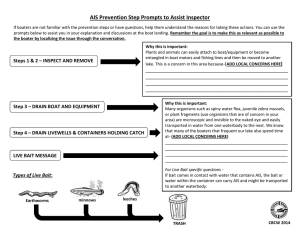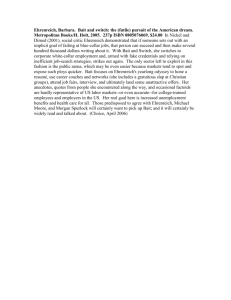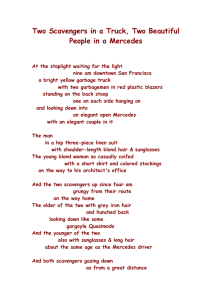Predator and scavenger aggregation to discarded by-catch from
advertisement
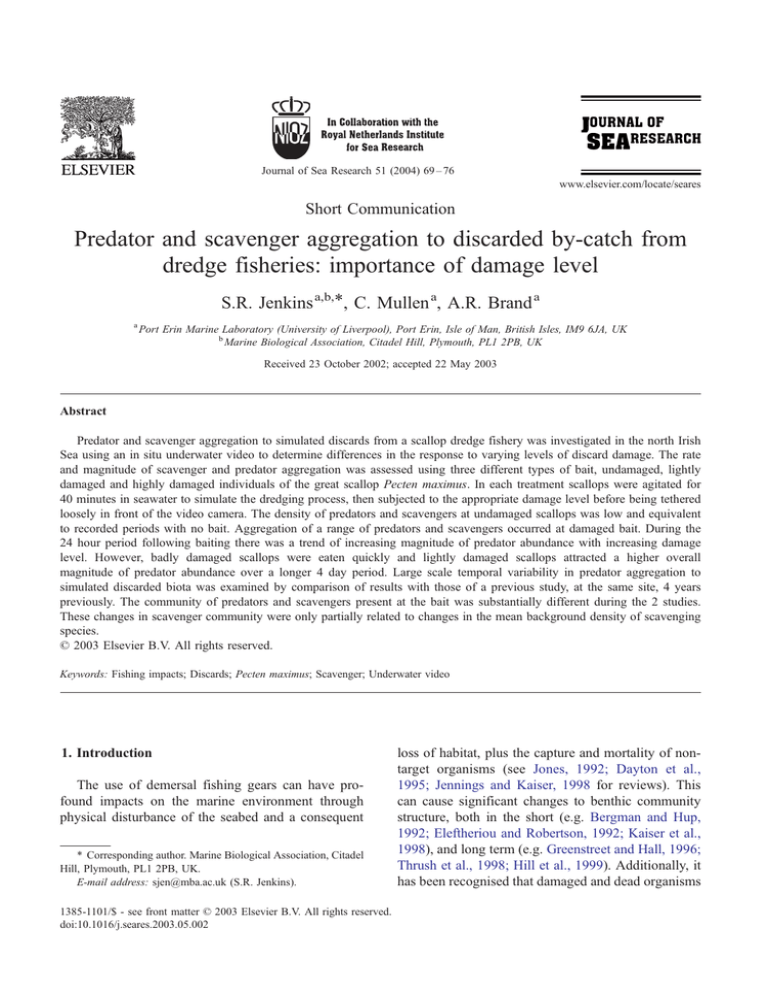
Journal of Sea Research 51 (2004) 69 – 76 www.elsevier.com/locate/seares Short Communication Predator and scavenger aggregation to discarded by-catch from dredge fisheries: importance of damage level S.R. Jenkins a,b,*, C. Mullen a, A.R. Brand a a Port Erin Marine Laboratory (University of Liverpool), Port Erin, Isle of Man, British Isles, IM9 6JA, UK b Marine Biological Association, Citadel Hill, Plymouth, PL1 2PB, UK Received 23 October 2002; accepted 22 May 2003 Abstract Predator and scavenger aggregation to simulated discards from a scallop dredge fishery was investigated in the north Irish Sea using an in situ underwater video to determine differences in the response to varying levels of discard damage. The rate and magnitude of scavenger and predator aggregation was assessed using three different types of bait, undamaged, lightly damaged and highly damaged individuals of the great scallop Pecten maximus. In each treatment scallops were agitated for 40 minutes in seawater to simulate the dredging process, then subjected to the appropriate damage level before being tethered loosely in front of the video camera. The density of predators and scavengers at undamaged scallops was low and equivalent to recorded periods with no bait. Aggregation of a range of predators and scavengers occurred at damaged bait. During the 24 hour period following baiting there was a trend of increasing magnitude of predator abundance with increasing damage level. However, badly damaged scallops were eaten quickly and lightly damaged scallops attracted a higher overall magnitude of predator abundance over a longer 4 day period. Large scale temporal variability in predator aggregation to simulated discarded biota was examined by comparison of results with those of a previous study, at the same site, 4 years previously. The community of predators and scavengers present at the bait was substantially different during the 2 studies. These changes in scavenger community were only partially related to changes in the mean background density of scavenging species. D 2003 Elsevier B.V. All rights reserved. Keywords: Fishing impacts; Discards; Pecten maximus; Scavenger; Underwater video 1. Introduction The use of demersal fishing gears can have profound impacts on the marine environment through physical disturbance of the seabed and a consequent * Corresponding author. Marine Biological Association, Citadel Hill, Plymouth, PL1 2PB, UK. E-mail address: sjen@mba.ac.uk (S.R. Jenkins). 1385-1101/$ - see front matter D 2003 Elsevier B.V. All rights reserved. doi:10.1016/j.seares.2003.05.002 loss of habitat, plus the capture and mortality of nontarget organisms (see Jones, 1992; Dayton et al., 1995; Jennings and Kaiser, 1998 for reviews). This can cause significant changes to benthic community structure, both in the short (e.g. Bergman and Hup, 1992; Eleftheriou and Robertson, 1992; Kaiser et al., 1998), and long term (e.g. Greenstreet and Hall, 1996; Thrush et al., 1998; Hill et al., 1999). Additionally, it has been recognised that damaged and dead organisms 70 S.R. Jenkins et al. / Journal of Sea Research 51 (2004) 69–76 impacted by demersal gear attract mobile scavengers and predators (e.g. Medcof and Bourne, 1964; Caddy, 1973; Kaiser and Spencer, 1994), and in intensively fished areas, this food source may form an important energy subsidy for marine food webs (Furness, 1996; Ramsay et al., 1997a). Assessment of scavenger and predator aggregation at damaged biota has been undertaken by direct observation of recently dredged or trawled areas (Caddy, 1973), by remote sampling of such areas (Kaiser and Spencer, 1994) and by the use of baited traps and underwater cameras (Ramsay et al., 1997a; Veale et al., 2000; Bozzano and Sarda, 2002). Such methods have demonstrated the importance of a range of physical and biological factors in influencing scavenger aggregation, including the physical characteristics of the site (Ramsay et al., 1997a), level of tidal flow (Nickell and Moore, 1992), bait type (Ramsay et al., 1997b) and species interactions (Ramsay et al., 1997b). Of the demersal fishing gears currently used, toothed scallop dredges, which are designed to dig into the sediment, may be amongst the most damaging to benthic communities (Dayton et al., 1995; Collie et al., 2000; Jenkins et al., 2001). We aimed to make preliminary observations on the rate and magnitude of predator and scavenger aggregation to simulated discarded by-catch with differing degrees of stress and damage and determine the extent to which the community of scavengers and the way in which bait is utilised varies. Most experimental studies of predator aggregation have used either dead (e.g. Nickell and Moore, 1992) or very badly damaged (e.g. Veale et al., 2000) bait to produce the maximum attractive effect. However, in demersal fisheries, both target and non target species of benthic invertebrates can show low levels of damage and high rates of survival (Kaiser and Spencer, 1995). A mono-specific bait consisting of Pecten maximus, the target species of the dredge fishery, was used with three levels of damage, from none to high. All three treatments underwent simulated dredging prior to deployment. We also assessed large scale temporal variability in scavenger aggregation by making comparisons with the work of Veale et al. (2000), which was undertaken at the same location ( F 100 m) and used the same baited camera technique 4 years previously. 2. Methods 2.1. Aggregation to bait The aggregation of predators and scavengers to bait on a scallop fishing ground in the north Irish Sea was assessed using a fixed underwater video camera between August 1st and September 26th 2000. A Rovtech Systems low-light colour camera with two 250W red filtered lights was used and the signal transmitted to shore via a 1000m cable. The camera was positioned on a Dexian frame at an angle of 45j, 1m above the seabed such that an area 1m wide could be viewed. The camera was located approximately 500m offshore, due west of Port Erin Marine Laboratory in a depth of water 20m below LAT (for location see Veale et al., 2000) in an area closed to dredging since 1989. Over the period of study the camera was baited by divers on nine separate occasions. The bait consisted of 12 scallops (Pecten maximus), loosely tethered using monofilament fishing line passed through small holes drilled in the anterior auricle of the shell and attached to a peg secured in the substratum in front of the camera. The scallops used as bait were subjected to three different treatments. Immediately prior to deployment in front of the camera, all scallops were subjected to simulated dredging in which they were agitated in seawater with sand and rocks for 40 minutes (see Jenkins and Brand, 2001 for details). The scallops were then either left undamaged, or subjected to low or high levels of damage. For low levels of damage a screwdriver was used to puncture the shell and remove fragments from the outer shell margin up to the mantle edge. For high levels of damage a hammer was used to break the shell in a number of places and cause damage to soft tissue. Each of the three treatments was replicated three times. For each replicate, the events following baiting were recorded for between four and seven days. In order to maintain independence between treatments, each replicate baiting event was either separated by a period of at least three days or the camera was moved a minimum distance of 50 m. Moving the camera, which was done on three occasions also served to limit the association of organisms with the camera frame. In addition to the experimental treatments, three periods of at least four days were recorded with no bait. S.R. Jenkins et al. / Journal of Sea Research 51 (2004) 69–76 71 one high damage level). Thus, data for only two replicates of each of the damage treatments are presented. 2.2. Background density of scavengers The benthic fauna of the fisheries exclusion zone where the study took place has been surveyed by divers at irregular intervals since the area was closed to fishing in 1989. Each survey consisted of nondestructive sampling of fauna within a 4m by 50m strip of seabed by a pair of divers. The dimensions of the sampling strip were delimited using a 4m sampling pole and a 50m ground line. 2.3. Data analysis Video tapes of the recorded periods were viewed on the time lapse video and instantaneous counts of all organisms were made every 10 minutes of real time. Because of the difficulty of determining whether certain organisms were feeding on the bait, counts were made of all organisms within the field of view, up to a depth of field of approximately 2m. 3. Results Technical problems resulted in insufficient recording for two baiting periods (one low damage level and 3.1. General observations Lightly damaged scallops were not eaten by any scavenger or predator until the action of large Crustacea (mainly Cancer pagurus) had made the body tissue available. On many occasions, plaice (Pleuroonectes platessa) were seen waiting and feeding at the chelae of crabs. Also the brittlestar, Ophiocomina nigra, although frequently dispersed during periods of intense activity by crabs and large fish, was attracted toward damaged scallops when C. pagurus was feeding. Highly damaged scallops provided a readily accessible, highly concentrated food source. This resulted in periods of intense feeding activity by large fish and crustaceans which disturbed the sediment and resulted in the dispersion of smaller organisms. At times up to 12 plaice were feeding at once; at others a mixed assemblage of large gadoids, flatfish and C. pagurus occurred. Although no undamaged scallops were eaten, C. pagurus was seen on a few occasions attempting to open shells by exploring the ventral shell margins with its chelae. However, such attempts rarely lasted more than a few minutes. Table 1 Percentage of instantaneous counts in which each of the taxa were recorded Baited periods Mollusca Crustacea Echinodermata Pisces Mammalia Eledone cirrhosa Loligo spp. Spider crabs Cancer pagurus Liocarcinus spp. Pagurus spp. Homarus gammarus Ophiocomina nigra Astropecten irregularis Asterias rubens Marthasterias glacialis Luidia ciliaris Callionymus lyra Scyliorhinus canicula Gadoids Aspitrigla cuculus Synagnathus spp. Flatfish Halichoerus grypsus (Grey seal) Non baited periods % occurrence Rank occurrence 0.1 0.1 11.2 7.7 3.4 0.7 0.1 99.3 0.3 0.1 1.2 0.6 30.6 2.7 5.2 0.7 0.1 7.6 0.1 15 16 3 4 7 11 18 1 13 14 9 12 2 8 6 10 17 5 19 % occurrence Rank occurrence 0.6 8 2.5 0.6 1.1 0.8 3 7 4 6 99.2 1 20.3 2 1.1 5 0.3 9 72 S.R. Jenkins et al. / Journal of Sea Research 51 (2004) 69–76 3.2. Predator and scavenger activity Nineteen taxa were observed during baited periods compared to only nine during periods with no bait. The majority of taxa were only occasional visitors to the baited area (Table 1) with only 6 appearing in more than 5% of counts at bait. The overall level of scavenger and predator activity for each treatment was calculated as the mean hourly abundance (i.e. the mean number of individuals of each taxa counted in each of the 6 instantaneous counts in one hour). For presentation, the mean hourly abundance was calculated over a 24 hour and a 96 hour period after baiting (Figs. 1 and 2). Fig. 1. Mean hourly abundance of the dominant invertebrate scavengers at unbaited and baited treatments over a 24 hour and a 96 hour sampling period. Error bar F 1SE. S.R. Jenkins et al. / Journal of Sea Research 51 (2004) 69–76 73 Fig. 2. Mean hourly abundance of the dominant fish scavengers at unbaited and baited treatments over a 24 hour and a 96 hour sampling period. Error bar F 1SE. For all taxa, for both observation periods (24 and 96 hour), there was little or no apparent difference in abundance between periods with no bait and undamaged bait. In contrast there was very clear aggregation of the most common taxa to damaged bait (Figs. 1 and 2). There were clear differences in the ranking of the low and high damage treatments for calculations based on a 24 and a 96 hour period. In the high damage treatment all scallops were eaten in both replicates in just over 24 hours. This concentration of feeding activity is reflected in the trend for greater mean abundance at high damage compared to low 74 S.R. Jenkins et al. / Journal of Sea Research 51 (2004) 69–76 damage treatments over the 24 hour period for the dominant scavengers Cancer pagurus, Ophiocomina nigra, flatfish and gadoids. In contrast over 96 hours most of the important scavengers showed a trend for greater mean abundance at the low damage treatment. Scallops with low levels of damage showed variable levels of survival in the three replicate baiting events with some still alive after 96 hours. Thus in the low damage treatment attractive bait was available for longer resulting in extended periods of scavenger activity in this treatment. The times of first appearance of the common taxa at the bait were compared between lightly and highly damaged bait. A lack of aggregation to undamaged bait precluded their inclusion in this comparison. There was no consistency in the rate of arrival of taxa between the two treatments (Fig. 3). 3.3. Background density of scavengers Dive surveys from 1996 and 2000 were used to estimate the density of scavengers in the experimental area in order to interpret temporal changes in scavenger aggregation between our study and that of Veale et al. (2000). Only surveys within a radius of approximately 400 m of the camera positions were used. Table 2 shows large changes in the mean density of some important scavengers. The density of the starfish Asterias rubens and Astropecten irregularis declined Fig. 3. Mean number of hours after baiting for appearance of dominant scavengers in low and high damage treatments. Error bar F 1SE. NB: Ophiocomina nigra was present at the experimental site prior to baiting. Table 2 Estimates of mean background density (per 100 m2) and standard deviation (in brackets) of dominant scavengers in the area of the baited camera during 1996 and 2000 Mean background Mean back ground density 1996 n = 14 density 2000 n = 5 Asterias rubens 10.36 (6.48) Astropecten irregularis 2.43 (2.94) Spider crabs 1.93 (1.22) Cancer pagurus 0.71 (0.70) Liocarcinus spp. 1.75 (2.59) Pagurus spp. 3.14 (2.37) Flatfish 0.32 (0.57) Callionymus lyra 2.25 (1.28) 0.3 0.2 3.0 0.4 0.2 9.9 0.2 2.6 (0.27) (0.27) (3.52) (0.89) (0.27) (7.5) (0.45) (1.64) Diver surveys were distributed at random in a 650 750 m area. n refers to the number of dive surveys carried out. by 34 and 12 fold respectively, while the density of the swimming crab declined from nearly 2 to only 0.2 per 100m2. 4. Discussion Our observations show that the pattern of predator and scavenger aggregation and subsequent dispersal from simulated by-catch discards differed among damage treatments. Firstly there was no apparent aggregation toward stressed but undamaged scallops. In contrast highly damaged scallops provided an attractive food source which was readily available to all scavengers and resulted in periods of intense feeding activity. Feeding was concentrated in the first 24 hours after baiting and over this period our data suggest an increasing level of scavenger aggregation with increasing damage level for 4 out of the 6 dominant scavengers. Lightly damaged scallops were not accessible as a food source to any scavengers except large edible crabs (Cancer pagurus). Feeding on this bait by the scavenger community was reliant on crabs breaking open the scallop shells, in the same way that extra-oral digestion of fish skin by Asterias rubens can facilitate scavenger feeding of fish bait (Ramsay et al., 1997a). As a result of a relatively inaccessible food source, feeding activity occurred over a protracted period, with some scallops still alive after 96 hours. Consequently the abundance of scavengers at the different damage S.R. Jenkins et al. / Journal of Sea Research 51 (2004) 69–76 treatments showed a different pattern when calculated over 96 hours, with 4 out of the 6 dominant scavengers showing greater abundance at lightly damaged bait. Aggregation of predators and scavengers to damaged scallops and the apparent lack of aggregation to undamaged ones, has implications for the benefits of improving fishing gear design. Our results suggest that improvements in gear design aimed at limiting mortality of discarded target and non-target species will only be effective where damage caused by gear is absent or negligible. Even a small degree of damage is likely to result in high levels of mortality where discards are spatially concentrated. Captured, but undamaged species, that are subsequently discarded may suffer high levels of stress (Maguire et al., 2002) that can affect behavioural response to predators (Ramsay and Kaiser, 1998; Jenkins and Brand, 2001). Jenkins and Brand (2001) have shown a marked reduction in the ability of dredged scallops to elicit an escape response following stimulation by a potential predator, and concluded that there is a potential for high levels of mortality in discarded individuals, even when they are undamaged. The results of the present study suggest that significant mortality will only occur in areas of high predator density. Comparison of our results with those of a previous study (Veale et al., 2000), carried out in 1996 at the same site, allows assessment of large scale temporal variability in predator aggregation. Although Veale et al. (2000) used a range of bait they found little difference in scavenger community composition between monospecific bait of Pecten maximus and other baits; thus, comparisons between the two studies are valid. There was a distinct difference in the community composition of scavengers between the two studies. In 1996, large aggregations of the predatory starfish A. rubens and Astropecten irregularis and the crab species Liocarcinus and Pagurus were observed. The starfish Asterias rubens was found in almost half of all video frames observed, compared to only 0.1% in our study. The differences in scavenger community found at baits in the two studies are likely to be a result of differences in the background density of scavengers. This is clearly the case for the starfish A. rubens and A. irregularis. For example, the density of Asterias rubens in the area of the fisheries exclusion zone 75 where the study was sited, declined from 10.4 individuals per 100 m2 in 1996 to only 0.3 individuals in 2000 (Table 2). However, not all changes in the pattern of predator aggregation can be explained by changes in the background density of individuals. For example, the density of C. pagurus was lower in 2000 than 1996, but we found this species was almost twice as abundant at bait than did Veale et al. (2000). In addition, hermit crabs were dominant scavengers in 1996, but despite an almost three fold increase in background abundance it was almost absent from bait in 2000. In a comparison of aggregation to bait in different habitats, Ramsay et al. (1997a) found that the density of scavengers at bait was only partially linked to the density of scavenging species in the surrounding area. Comparisons over time at the same location (i.e. comparison between the present study and that of Veale et al., 2000), show that there is temporal as well as spatial variability in the link between aggregation level and density. Differences in both physical (tidal stream strength) and biological (natural food availability) aspects of the environment may explain the variability in level of aggregation among habitats (Ramsay et al., 1997a). The physical attributes of the experimental site in our study did not change over time, but the level of food availability is unknown. One factor not considered is small scale (10’s metres) variability in the density of scavengers with limited mobility. In the north Irish Sea around the Isle of Man, the gravely substratum shows a high degree of spatial heterogeneity at a range of spatial scales (Bradshaw et al., 2000; Jenkins et al., 2001), resulting in patchy distribution of epifauna. Given that many invertebrate scavengers are attracted to bait over limited distances (e.g. Himmelman, 1988; McQuinn et al., 1988) and have low mobility, spatial patchiness will play an important part in dictating the community of scavengers at discarded material. In summary, we showed that the degree of damage level in discarded biota resulted in differences in the behaviour of scavengers and the period of scavenger activity. Comparison with a previous study demonstrated large scale temporal variability over years, and illustrates that generalisations regarding scavenger community composition for a particular area or habitat may not be possible. 76 S.R. Jenkins et al. / Journal of Sea Research 51 (2004) 69–76 Acknowledgements This study was supported by the EU project ECODREDGE (FAIR CT98-4465) and the Department of Agriculture Fisheries and Forestry of the Isle of Man Government. Write up of the work was supported by an MBA fellowship to SRJ. Thanks to the boat crew of the Sula and to divers Mike Bates and Matthew Mosley. Lewis Veale provided excellent advice on the logistics of the video camera set up, and along with Clare Bradshaw, gave access to dive survey data. References Bergman, M.J.N., Hup, M., 1992. Direct effects of beam trawling on macrofauna in a sandy sediment in the southern North Sea. ICES J. Mar. Sci. 49, 5 – 11. Bozzano, A., Sarda, F., 2002. Fishery discard consumption rate and scavenging activity in the northwestern Mediterranean Sea. ICES J. Mar. Sci. 59, 15 – 28. Bradshaw, C., Veale, L., Hill, A.S., Brand, A.R., 2000. The effects of scallop dredging on gravelly sea-bed communities. In: Kaiser, S., DeGroot, S. (Eds.), Effects of fishing on non-target species and habitats. Gray Publishing, Tunbridge Wells, pp. 83 – 104. Caddy, J.F., 1973. Underwater observations on the tracks of dredges and trawls and some effects of dredging on a scallop ground. J. Fish. Res. Bd Can. 30, 173 – 180. Collie, J.S., Hall, S.J., Kaiser, M.J., Poiner, I.R., 2000. A quantitative analysis of fishing impacts on shelf-sea benthos. J. Anim. Ecol. 69, 785 – 798. Dayton, P.K., Thrush, S.F., Agardy, T., Hofman, R.J., 1995. Environmental effects of marine fishing. Aquatic Conservation: Marine and Freshwater Ecosystems 5, 205 – 232. Eleftheriou, A., Robertson, M.R., 1992. The effects of experimental scallop dredging on the fauna and physical environment of a shallow sandy community. Neth. J. Sea Res. 30, 289 – 299. Furness, R., 1996. A review of seabird responses to natural or fisheries induced changes in food supply. In: Greenstreet, M.L., Tasker, M.L. (Eds.), Aquatic predators and their prey. Blackwell Scientific, Oxford, pp. 168 – 173. Greenstreet, S.P.R., Hall, S.J., 1996. Fishing and the ground-fish assemblage structure in the north-western North Sea: an analysis of long-term and spatial trends. J. Anim. Ecol. 65, 577 – 598. Hill, A.S., Veale, L.O., Pennington, D., Whyte, S.G., Brand, A.R., Hartnoll, R.G., 1999. Changes in Irish Sea benthos: possible effects of forty years of dredging. Estuar. Coast. Shelf Sci. 48, 739 – 750. Himmelman, J.H., 1988. Movement of whelks (Buccinum undatum) towards a baited trap. Mar. Biol. 97, 521 – 531. Jenkins, S.R., Beukers-Stewart, B., Brand, A., 2001. Impact of scallop dredging on benthic megafauna: a comparison of damage levels in captured and non-captured organisms. Mar. Ecol. Prog. Ser. 215, 297 – 301. Jenkins, S.R., Brand, A., 2001. The effect of dredge capture on the escape response of the great scallop, Pecten maximus (L.): implications for the survival of undersized discards. J. Exp. Mar. Biol. Ecol. 266, 33 – 50. Jennings, S., Kaiser, M.J., 1998. The effects of fishing on marine ecosystems. Adv. Mar. Biol. 34, 201 – 351. Jones, J.B., 1992. Environmental impact of trawling on the seabed: A review. New Zealand Journal of Marine and Freshwater Research 26, 59 – 67. Kaiser, M.J., Edwards, D.B., Armstrong, P.J., Radford, K., Lough, N.E.L., Flatt, R.P., Jones, H.D., 1998. Changes in megafaunal benthic communities in different habitats after trawling disturbance. ICES J. Mar. Sci. 55, 353 – 361. Kaiser, M.J., Spencer, B.E., 1994. Fish scavenging behaviour in recently trawled areas. Mar. Ecol. Prog. Ser. 112, 41 – 49. Kaiser, M.J., Spencer, B.E., 1995. Survival of by-catch from a beam trawl. Mar. Ecol. Prog. Ser. 126, 31 – 38. Maguire, J., Coleman, A., Jenkins, S.R., Burnell, G., 2002. Effects of dredging on undersized scallops. Fisheries Research 56, 155 – 165. McQuinn, I.H., Gendron, L., Himmelman, J.H., 1988. Area of attraction and effective area fished by a whelk (Buccinum undatum) trap under variable conditions. Can. J. Fish. Aq. Sci. 45, 2054 – 2060. Medcof, J.C., Bourne, N., 1964. Causes of mortality of the sea scallop, Placopecten magellanicus. Proceedings of the National Shellfisheries Association 53, 33 – 50. Nickell, T.D., Moore, P.G., 1992. The behavioural ecology of epibenthic scavenging invertebrates in the Clyde Sea area: Laboratory experiments on attractions to bait in moving water, underwater TV observations in situ and general conclusions. J. Exp. Mar. Biol. Ecol. 159, 15 – 35. Ramsay, K., Kaiser, M.J., 1998. Demersal fishing disturbance increases predation risk for whelks (Buccinum undatum L.). J. Sea Res. 39, 299 – 304. Ramsay, K., Kaiser, M.J., Hughes, R.N., 1997a. A field study of intraspecific competition for food in hermit crabs (Pagurus bernhardus). Estuar. Coast. Shelf. Sci. 44, 213 – 220. Ramsay, K., Kaiser, M.J., Moore, P.G., Hughes, R.N., 1997b. Consumption of fisheries discards by benthic scavengers: utilization of energy subsidies in different marine habitats. J. Anim. Ecol. 66, 884 – 896. Thrush, S.F., Hewitt, J.E., Cummings, V.J., Dayton, P.K., Cryer, M., Turner, S.J., Funnell, G.A., Budd, R.G., Milburn, C.J., Wilkinson, M.R., 1998. Disturbance of the marine benthic habitat by commercial fishing: Impacts at the scale of the fishery. Ecol. Appl. 8, 866 – 879. Veale, L.O., Hill, A.S., Brand, A.R., 2000. An in situ study of predator aggregations on scallop (Pecten maximus (L.)) dredge discards using a static time-lapse camera system. J. Exp. Mar. Biol. Ecol. 255, 111 – 121.
